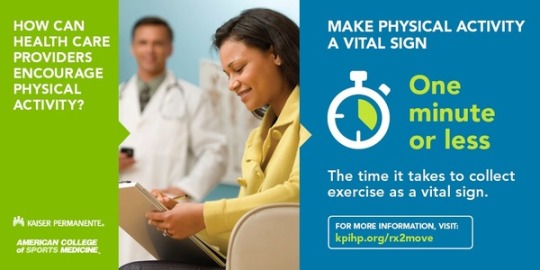Cross-posted from Kaiser Permanente Total Health Partnerships Listserv

Physical activity, healthy eating and managing stress are all important factors to achieve total health. However, consider this alarming statistic: only about half of Americans meet the recommended 150 minutes a week of moderate aerobic activity. To help get people moving, health care providers must become better health champions.
The first step is spreading the word on actions that work, which is why the Kaiser Permanente Institute for Health Policy and American College of Sports Medicine are offering three strategies for health care leaders to promote physical activity and to shape environments to support active living. These include encouraging physical activity in conversations with patients, redesigning health care environments and investing in communities.
Join us for the first of a three-part Prescription to Move (#Rx2Move) webinar series, Making Physical Activity a Vital Sign, on Tuesday, October 13, 12:30-1:30 PM Pacific/3:30-4:30 PM Eastern.
Rx2Move is designed to raise awareness for the ways health care providers can increase physical activity of their patients and communities, and close the physical activity gap by:
- Making Physical Activity a Vital Sign — Conversations between health care providers and patients about physical activity, followed by referrals to safe and affordable places to be active, can improve health.
- Designing Active Care Environments — Designing innovations, and the organizational policies supporting them, can increase physical activity rates of patients, visitors and staff; and provide opportunities to engage in “active transportation” (walking, biking and connecting to public transit).
- Investing in Community Health — Advocating for and investing in active transportation infrastructure, safe routes that connect, natural spaces for recreation and community and school based-health initiatives.
For more information, download the policy brief, “How Health Care Providers Can Encourage Physical Activity for Patients and Communities.”
We hope you can join the upcoming webinar, and thank you for supporting #Rx2Move.